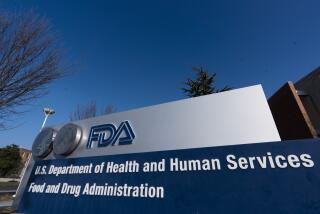A Window Into Treatments
- Share via
Regardless of your age, the earlier you treat cancers and precancerous conditions, the better the outcome, and the greater your options for less-invasive therapy. The following are the major types of cancers and treatment options:
Actinic Keratosis
A pre-cancer growth that appears on sun-exposed areas of the face and hands as a scaly, rough, raised, red and occasionally bleeding patch. It signals that skin cells are undergoing changes that could lead to cancer. Up to 5% of these scaly growths will become squamous cell carcinomas. President Bush had two such growths removed from his face last August. Sometimes, this diagnosis reforms even the most avid sun worshippers. Take Staci Howard, a 34-year-old Studio City writer who never applied sunscreens in the years she nurtured a tan on beaches and in tanning salons. Having an actinic keratosis removed from her upper lip last year convinced her to give up tanning: “It took me a long time to kind of grow up about this.”
Treatments: Most often, an actinic keratosis can be frozen off with liquid nitrogen. It can be removed by surgical shaving, cutting or lasering. Chemical peels with trichloroacetic acid or glycolic acid can be effective in treatment and prevention. Nonsurgical options include the repeated at-home application of 5-fluorouracil, also known as 5FU or Efudex, which causes redness and inflammation. Some doctors prescribe a less-irritating formulation, called Carac.
Dermatologists cite a promising topical treatment called Aldara, the brand name for imiquimod, previously used on genital warts. Dr. David J. Leffell, a Yale University dermatologist, says Aldara is the first in a new category of skin-cancer drugs that work by recruiting the body’s own disease-fighting systems to attack cancer cells. The FDA has approved a topical version of an anti-inflammatory drug, diclofenac, marketed as Solaraze, for actinic keratoses, and clinical trials are examining whether the oral anti-inflammatory drug Celebrex can eliminate them.
Doctors treat small actinic keratoses with photodynamic therapy, a two-step process that begins with the application of Levulan, which is absorbed by the precancerous cells, followed 16 hours later by exposure to a blue light that activates the drug and destroys the cells. One session usually does the trick, but patients experience some burning and discomfort afterward and sometimes encounter difficulty getting insurers to cover it.
The anti-acne, anti-wrinkle cream Retin A, one of the class of vitamin A-related retinoids, eliminates actinic keratoses in many patients.
Basal Cell Carcinoma
The most common skin malignancy, it affects about 800,000 Americans each year and accounts for about 75% of skin cancers. It is rarely fatal. The condition is predominantly caused by sun exposure, but doctors believe some people are genetically predisposed to it. This slow-growing cancer often appears as a firm, flat, pale area or as a small, pink or red shiny or waxy area. It often affects fair-skinned people.
Treatments: Superficial basal cell carcinomas respond well to Aldara, said Dr. Arnold W. Klein, a Beverly Hills dermatologist. Options include freezing with liquid nitrogen (which leaves a blister and scar), radiation (a less attractive option in young patients), scraping with a curet and destroying remaining cells with electric needles, or vaporizing with lasers.
You may want to find a dermatologist with specialized training in Mohs micrographic surgery. This technique, covered by insurance, allows the doctor to remove the cancerous growth and do instant microscopic analysis to ensure that all the diseased tissue has been removed, saving the patient the time and expense of waiting for lab results and a possible repeat visit.
Mohs surgery is preferred in delicate or difficult areas, such as the nose, ears, around the eyes, forehead, fingers, genitals or where cancer has recurred.
Squamous Cell Carcinoma
This appears as lumps or sometimes rough-looking or flat reddish patches. The Skin Cancer Foundation estimates 200,000 U.S. cases are diagnosed annually, accounting for about 20% of skin cancer, most often on sun-exposed areas. Because it can invade the lymph nodes and other tissues, it causes about 2,000 deaths each year.
Treatments: It can be removed with simple excision, although that typically requires removing more tissue than with Mohs surgery, which gets the highest cure rates. Doctors may suggest electrodessication and curettage, freezing or radiation. If it spreads, it may be treated with systemic chemotherapy.
Yale’s Leffell is optimistic that Dimericine, a cream containing an enzyme that repairs damaged DNA, might be the long-sought “morning-after” cream that could undo the solar ravages that produce squamous cell carcinoma. He cited a study in which people with xeroderma pigmentosum, an inherited condition that produces numerous cancerous and precancerous skin lesions, had 60% fewer new lesions when they applied Dimericine.
Melanoma
Originating in melanocytes, the skin’s pigment-producing cells, it can spread to major organs and tissues. It tends to appear on men’s upper backs and women’s lower legs, but can turn up anywhere. Risks include genetics, a history of many skin moles, severe sunburns and tanning-bed use. It accounts for 4% of skin-cancer cases and causes 79% of skin-cancer deaths. This year, the American Cancer Society estimates 53,600 people will be diagnosed with malignant melanoma (5,300 of them in California), and 7,400 of them will die.
Treatments: If caught early, melanoma is more than 96% curable. Researchers are working on better devices to map moles and detect earlier any changes requiring a biopsy. Doctors characterize melanoma by stages based upon thickness and involvement of lymph nodes or organs; those stages were revised this year. In many cases, dermatologists refer patients for sentinel node biopsy, which involves injection with a special dye that helps identify lymph nodes the tumor drains into. There is no cure for advanced melanoma; chemotherapy and immunotherapy typically buy extra time. Several melanoma clinical trials are testing gene therapy to replace damaged cells, make the melanoma more sensitive to treatment, or deliver vaccines directly into the diseased cells. With any skin cancer, find a doctor experienced in diagnosis and treatment. Dermatologists, trained in the biology of skin, have varied practices: Some specialize in acne and wrinkles; others in cancer and surgery. Ask your doctor whether surgical treatment of skin cancer is a big part of the practice, or whether he or she typically refers patients to Mohs surgeons.






